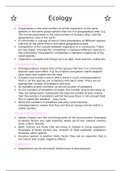Ecology
Communities:
A population is the total number of all the organisms of the same
species or the same group species that live in a geographical area. E.g.
The human population is the total number of humans alive, and the
geographical area is the earth.
A community is a group of two or more populations of different species
that live at the same time in the same geographical area.
Competition is the contest between organisms in a community. There
are two types; Interspecific competition is between different species in
the community, Intraspecific competition is between organisms of the
same species.
Organisms compete over things such as light, food, warmth, mates etc.
Interdependence:
Interdependence means that all the species that live in a community
depend upon each other. E.g. In a marine ecosystem sharks depend
upon seals and smaller fish for food.
A stable community is one in which there is much interdependence.
That is, all the species are in balance with each other. There are an
appropriate number of predators and prey.
As numbers of prey increase, so do the number of predators.
As the numbers of predators increase, the number of prey decrease as
they are being eaten. Eventually the reduced number of prey means
that the number of predators will fall because there is not enough food.
This is called the predator – prey cycle.
While the numbers of predators and prey cycle naturally,
interdependence means that they will almost always remain within a
stable number.
Abiotic and Biotic Factors:
Abiotic Factors are the non-living parts of the environment. Examples
of abiotic factors are, light intensity, water, pH of soil, mineral content,
wind, carbon dioxide.
Biotic Factors are those that are living or related to living organisms.
Examples of biotic factors are, amount of food available, predators,
diseases, other species.
Invasive species is another biotic factor they are an organism that is
not native and causes negative effects.
Adaptations:
Adaptations can be structural, behavioural or physiological.
, Structural adaptations are the physical features that allow an organism
to compete. E.g. the sharpness of a tiger’s teeth. Some animals might
mimic the adaptations of others.
Behavioural adaptations explain how specific behaviours benefit an
organism. For example, dancing to attract a mate
Physiological / Functional adaptations are processes that organisms
complete to help them survive. E.g. venom
Extreme Environments:
An extreme environment is one that is challenging for most organisms
to live within. These may be highly acidic or alkaline, hot or cold, they
may not have much oxygen or water of the ocean.
The artic is very cold meaning animals and plants must adapt e.g. polar
bears have a small head and ears to prevent heat loss, and they have a
thick layer of fat under their fur.
A Deep-sea hydrothermal vent is a small gap of fissure on the bottom
of the ocean, they are under extreme pressure and there is no light,
but some bacteria have evolved to feed on the chemicals released by
the vents.
An organism that lives in an extreme environment is called an
extremophile
Levels of organisation:
An ecosystem is a community of living organisms in their environment.
A community is a group of two or more populations of different species
living at the same time in the same place.
A population is the total number of organisms of the same species or
similar species that live in the same place.
Sampling is a process by which scientists look at a part of a habitat and
draw conclusions about the whole of it. For example, the amount of a
species.
Quadrats are used in many forms of sampling. A quadrat is simply a
square of wire or wood frame that is placed on the ground and the
organisms that are within it are recorded.
Random Sampling is where you place the quadrat at random places in
the set area and record the amount and multiply them to find the total
estimated amount in the area. Obviously, the more samples you do the
more accurate the data will be.
Systematic Sampling is where you place the quadrat at set places for
example 2 metres apart.
Producers, consumers and Decomposers:
There are three ways in which organisms obtain the energy store they
need to live. They can produce the energy they need. They can
consume other living organisms that have already produced this
energy sore. OR they can obtain it from the bodies of dead organisms.





